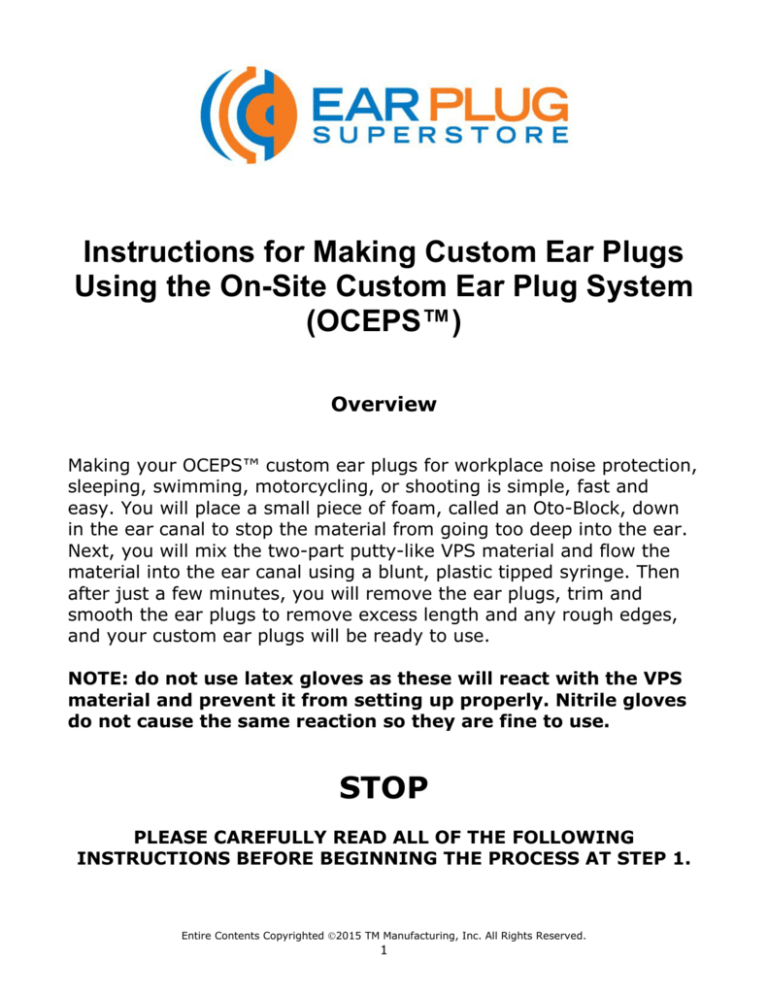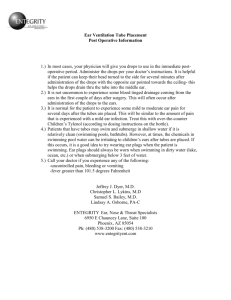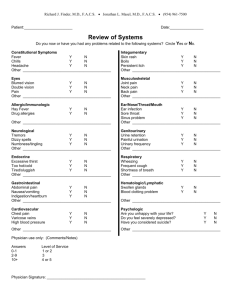
Instructions for Making Custom Ear Plugs
Using the On-Site Custom Ear Plug System
(OCEPS™)
Overview
Making your OCEPS™ custom ear plugs for workplace noise protection,
sleeping, swimming, motorcycling, or shooting is simple, fast and
easy. You will place a small piece of foam, called an Oto-Block, down
in the ear canal to stop the material from going too deep into the ear.
Next, you will mix the two-part putty-like VPS material and flow the
material into the ear canal using a blunt, plastic tipped syringe. Then
after just a few minutes, you will remove the ear plugs, trim and
smooth the ear plugs to remove excess length and any rough edges,
and your custom ear plugs will be ready to use.
NOTE: do not use latex gloves as these will react with the VPS
material and prevent it from setting up properly. Nitrile gloves
do not cause the same reaction so they are fine to use.
STOP
PLEASE CAREFULLY READ ALL OF THE FOLLOWING
INSTRUCTIONS BEFORE BEGINNING THE PROCESS AT STEP 1.
Entire Contents Copyrighted 2015 TM Manufacturing, Inc. All Rights Reserved.
1
Step 1: Check your supplies.
Before handling any materials in the kit make sure your hands
are clean.
Depending on the specific kit you have ordered, your OCEPS™ kit will
contain all of the following critical components:
One two-part packet of VPS material for each pair of full sized ear
plugs you will make with the kit.
In each packet will be one pair of each size Oto-Block; small and
large, as well as a Cotton swab which you will use to place the
Oto-Blocks in the ear canals.
One plastic tipped syringe.
These instructions.
If anything is missing please contact Ear Plug Superstore for
assistance: custom@earplugstore.com or call 918-478-5500.
Step 2: Read all the instructions.
Before doing anything else, read all of the instructions so that you can
move quickly through the steps. Once you mix the
two-part VPS material, it will rapidly begin to set up,
so be fully prepared before you begin.
The temperature of the material can affect the setup
time. The warmer the temperature of the material,
the faster it tends to set up, so if the material is
above 80 degrees Fahrenheit, put it into the
refrigerator for an hour or more before using. At a
cooler temperature the material will not set up as
quickly, giving you more time to work with it. You can leave the
material in the refrigerator indefinitely without harm.
Step 3: Examine the Ears
Before beginning the process of making the ear plugs, shine a light
into the ear canal and look carefully to make sure the canal is clear of
debris and signs that suggest medical problems. The ear canal should
be clean and healthy, and it should become smaller as you look deeper
into the canal. Common conditions to look for are heavy buildup of ear
wax, open sores, and deformities of the canal in which the canal opens
Entire Contents Copyrighted 2015 TM Manufacturing, Inc. All Rights Reserved.
2
up as it gets deeper. If you suspect any of these conditions are
present, do not proceed until the conditions have been checked
by a physician.
Step 4: Insert the Oto-Blocks (Foam Stops)
Put the largest foam stop into the ear canal, using the Cotton swab to
gently push the Oto-Block down into the canal, checking to make sure
it fits properly. The foam should fill the ear canal, but should not be
difficult to insert. If the foam piece is too large, try a smaller one. Be
sure the string hangs out of the ear canal when the Oto-Block is in
place. The string may be needed later to help remove the Oto-Block
from the ear canal. If the large Oto-Block is too small, use two OtoBlocks together so the ear canal is completely blocked. Repeat with
the other ear.
When properly placed, the Oto-Block should be just past the second
bend in the ear canal and nearly or completely out of sight around the
bend when you look into the canal after placement. The depth of the
finished ear plug is an important factor in how well the finished ear
plugs will block sound, so be sure to get the Oto-Blocks inserted
deeply, and well down in the canal. Once the plugs are finished, you
can readily trim the canal length if it is too deep, but you cannot add
material to the finished plugs if they are too short.
Be very gentle in placing the Oto-Block, and stop if the client becomes
uncomfortable or coughs, which is a natural reflex when an object is
too deep in the canal. Alternatively, you can place the Oto-Block just
inside the canal opening and then let the client push it down into the
canal using the cotton swab themselves, and then look to make sure it
is deep enough.
Step 5: Divide and
Mix the VPS Material
Remember: Do not use
Latex Gloves!
With the Oto-Blocks
properly in place in both
ears, prepare the two-part
VPS material for one ear at
a time. Using clean hands, remove all of the color material from its
Entire Contents Copyrighted 2015 TM Manufacturing, Inc. All Rights Reserved.
3
container, and divide into two equal parts. Next, remove all of the
hardener from its container and divide into two equal parts as well.
Now, combine one piece of the color material with one piece of the
hardener and knead the two blobs of material together in your fingers,
working quickly, until the mass is a uniform color. Aim to complete the
mixing within 15-20 seconds to avoid having the material set up
before you can get it into the ear.
As you become more experienced, you may elect to mix a full set of
material instead of just enough for one ear plug, and fill both ears in
sequence, then go back and dress the plugs as described in
subsequent steps.
Step 6: Put the Mixed VPS Material
into the Syringe
Remove the plunger from the syringe, place the
kneaded material into the syringe and use the
plunger to push the material down into the tip
until it is within 1/8” or so of the tip of the
syringe. This will remove the air pockets from
the material.
Step 7: Open Mouth and Insert the
Bite Block
If you are planning to make open-mouth ear plugs, open your mouth
and insert the bite block (not included in the trial kit) between your
front teeth using the notch that best suits you. Then bite gently on the
bite block to hold your jaws still throughout the remainder of the
procedure. The effect of using a bite block is to slightly enlarge the ear
canal, which produces slightly larger finished ear plugs. Because they
fit more snugly in the ear, the seal they make in the canal will be more
likely to remain intact even when the mouth is opened, as in singing or
gulping a big breath while swimming. For applications in which you will
not be opening your mouth a lot, such as sleeping, motorcycling, or
factory work, we generally recommend closed-mouth ear plugs which
are more comfortable for long-term wear, but for any application
where you will be talking a lot and especially for singing, we
recommend open-mouth impressions.
Entire Contents Copyrighted 2015 TM Manufacturing, Inc. All Rights Reserved.
4
Step 8: Fill the Ear Canal and the Bowl of the Outer Ear
Using one hand to actuate the syringe and the
other to hold the syringe steady, carefully place
the tip of the syringe about ¼ to ½ inch inside
the ear canal opening, and not touching the
sides of the ear canal. Use the plunger to flow
the impression material into the ear canal, while
holding the syringe steady. As the material fills
the ear canal it will reach the foam stop then
back up and start to flow out around the tip of
the syringe. As it flows out around the tip,
slowly withdraw the syringe and continue filling
the canal, and then the outer ear as desired.
Step 9: Dress the VPS Material by Lightly Tamping,
Shaping and Smoothing it to Form the Ear Plugs
Using your finger, lightly tamp the material all over the plug, shaping
and smoothing to eliminate ridges, air bubbles, and sharp edges,
especially around the outer edges of the ear plug. Be careful not to use
too much force so that you do not deform the ear plug. If you do not
get it perfect at this point, you can always trim or sand out remaining
rough spots after curing.
Step 10: Let the VPS Material Cure Completely
Now relax, keeping your jaws still, whether open or closed, and wait 510 minutes for the material to set up. When ready, the material will be
firm to the touch and will not give when pressed on by your finger.
Allowing ample time to for the material to cure will ensure that your
ear plugs will retain their shape after removal from the ear.
If you are not sure the ear plugs are completely
cured, wait a little longer. The material should not
yield to a firm touch. If you remove the material
too early, you may distort the ear plugs, especially
the canal portion, which will potentially result in
discomfort or a poor seal against water and/or
noise.
While you are waiting for the first ear plug to set
up, repeat steps 5 through 10 for the other ear.
Entire Contents Copyrighted 2015 TM Manufacturing, Inc. All Rights Reserved.
5
Step 11: Carefully Remove the Ear Plugs
When you are sure the ear plugs are fully cured, remove each ear plug
by working your fingers under the edges of the plug and gently prying
it out, rotating the plug forward toward the face as you remove it. If
an Oto-Block does not come out with the plug, use the string too
carefully and gently pull it out. Do not pull the string to remove the
plug itself though.
Step 12: Finish the Ear Plugs
Clean any earwax off of the ear plugs using an alcohol wipe or soap
and warm water. Dry thoroughly. Using a razor blade or scissors, trim
the canal to remove a little of the canal end where it touched the OtoBlock, and use an emery board or sandpaper (not included in the kit)
to round the end of the canal and to remove any sharp edges on the
outer parts of the ear plug.
Apply a small dab of Oto-Ease to each plug, and assist the client in
reinserting the ear plugs. Insertion is facilitated by rotating the plug
toward the back of the head as it is gently pushed into place. Be
careful at this point, to keep track of which ear plug is right and which
is left. Ask the client to identify any issues of pain or pressure. Remove
the offending plug, clean off the Oto-Ease, sand carefully to address
the issue and retry. Repeat until the plugs fit satisfactorily.
If you find that either ear plug does not have a well filled canal or
other deformation that interferes with a comfortable secure fit, discard
that plug and make a new one. You will get better with practice.
Once you are satisfied with the finished ear plugs, attach screw-in
lanyard ends or screw-in handles being careful to attach the red end
(“Red is Right”) to the right ear plug (not included in the kit), give the
ear plugs a final cleaning and they are ready for use. Handles are not
required but they do make the plugs easier to insert and remove.
Questions? Please contact Ear Plug Superstore.
Office hours:
Email:
Phone:
Fax:
Mail:
M-F 9:00-5:00 Central Time
custom@earplugstore.com
(918) 478-5500
(918) 512-4188
1709 Bell Road
Fort Gibson, OK 74434
Entire Contents Copyrighted 2015 TM Manufacturing, Inc. All Rights Reserved.
6






